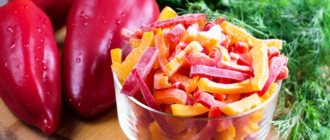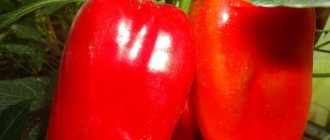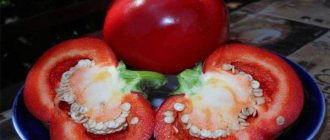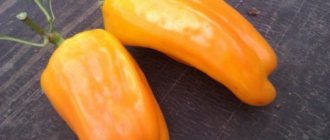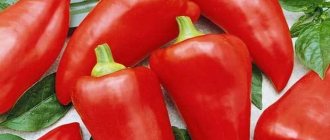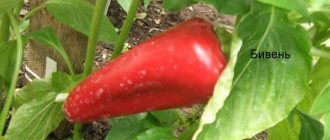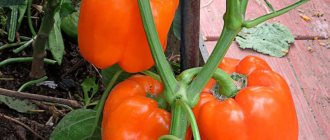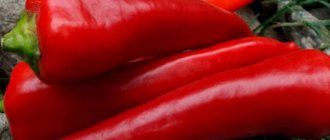Growing a Bell pepper can take a lot of effort. Currently, the species diversity of peppers is amazing. They are cuboid, spherical, or cone-shaped. Peppers are truly amazing in their variety of fruit colors; they come in red, yellow, green, orange, brown and even white and black. Therefore, it is not easy for any gardener to choose the same pepper seeds in the store, since it is very easy to get confused when looking around the shelves.
Today we will tell you about the Bell pepper. As you understand from the name, the name of this variety comes from the specific shape of the fruit. Yes, yes, Bell peppers resemble a flower bud, namely a bell. South America is considered the birthplace of this variety, but it is popular all over the globe. In our country, the hot Bell pepper has become widespread quite recently, but every summer resident dreams of growing such an exotic plant on his or her property.
Hot pepper Bell: variety description and reviews
Pepper is one of the popular vegetable crops. Thanks to the beneficial substances contained in the fruit, it is included in the healthy diet. There are many different varieties of peppers.
This article will talk about the Bell variety. It is grown both in open ground and in closed conditions: greenhouses, greenhouses, and at home. The Bell pepper variety is an intermediate option between bitter, hot types of pepper and Bulgarian. Read more about the variety below.
Interesting video
We bring to your attention a video about growing bell peppers on the balcony:
Among the many types of chili, a spice that has a fiery taste, there are varieties that are especially hot. We invite you to get acquainted with one of the hottest peppers in the world - the Habanero.
A little history
The Bluebell plant is native to South Africa. It was widespread throughout India. Externally, the shape of the fruit resembles the bell of the same name, in honor of which it received its name.
It appeared in Russia only a few decades ago. Its seeds are rare in stores and have a high price.
Similar to bell peppers and hot peppers. The fruits acquire a spicy taste and aroma in accordance with the ripening process.
Hot pepper Bell photo
Comparison with similar varieties
The bell is considered a unique variety that has no analogues. Its distinctive feature is the unusual shape of the fruit. The product also differs from chili pepper in taste. The upper part of the Bell pepper has a spicy taste, and the lower walls become thicker and sweeter.
Bell pepper is considered an interesting plant that has many benefits. The culture is undemanding to care and has a pleasant taste. That is why many gardeners grow it on their plots.
Pepper Bell: characteristics and description of the variety
The appearance of the bush resembles a variety of hot peppers. However, unlike the latter, it has slightly pubescent leaves and stems. The plant grows up to 2 meters in height.
The growing season lasts from 130 to 150 days. The fruits have an elongated, oblong shape, and, as noted above, they look like a familiar flower - a bell. From a botany point of view, the crop, like tomatoes, belongs to berry crops. However, many people still consider pepper to be a vegetable.
At the stage of technical maturity, when the fruits can already be harvested, they have a rich, dark green color. In just a week they gain color, first becoming orange and then red. At the same time, taste is formed.
Ripe fruits have a rich aroma, a piquant taste, combining bitterness with sweet-spicy notes.
The yield of the Bell variety (with proper care and good conditions) reaches 2 kg per bush.
The weight of the fetus can vary from 30 to 100 grams. Each fruit has a separate, own stalk.
Disease resistance of the variety
To avoid late blight infection, it is recommended to plant peppers away from tomatoes, potatoes and other members of the Solanaceae family. Before flowering begins, it is permissible to spray the plantings with a fungicide.
Important! When the fruits set, to prevent infection by fungi, it is worthwhile to treat the bushes several times with whey. To 10 liters of the substance you should add 20 drops of iodine solution.
Young bushes may suffer from attacks by Colorado potato beetles. Parasites eat young stems. To avoid this, after planting the plants should be moistened generously with soapy water and sprinkled with ash.
The benefits of Bell pepper and its use in cooking
Red Bell pepper has a spicy taste. It contains a lot of useful substances that have a beneficial effect on the body. Thus, ripe peppers contain a large amount of B vitamins, which promotes the production of the “joy” hormone - serotonin, which is responsible for a good mood.
Gardeners' choice!
• Time-tested pepper SWALLOW
In addition, it has the following beneficial properties:
- strengthens the functioning of the heart and blood vessels;
- relieves the body of cholesterol;
- strengthens the body's protective properties;
- has a calming effect on the central nervous system;
- excellent vision prevention;
- has a cosmetic effect in the form of strengthening nails and hair follicles of the skin.
These are the main beneficial properties of Bell pepper.
Due to its unusual taste, it is widely used in cooking. It is consumed fresh, as part of light salads or simply sliced. Well suited for preparing winter snacks, pastas, sauces.
All of the above advantages are an excellent reason to think about growing the Bell variety.
How to grow seedlings yourself at home
In order to grow seedlings yourself, it is important to take into account all the subtleties of preparation for this stage.
Need to know:
- how to choose the right seeds;
- optimal timing for sowing;
- soil composition and how to disinfect it;
- how to care for seedlings;
- procedure for hardening seedlings.
Optimal timing for sowing
This variety ripens in a period of 140 to 150 days . For a gardener, this means that you first need to sow the seeds, and then pick the pepper, let it grow a little, and only then plant it in open or closed ground.
It is worth considering that pepper seeds can take a long time to germinate. The optimal time for sowing seeds is at the end of February - beginning of March. It is important to choose a time of year when the danger of frost has passed, otherwise the seedlings will die from the cold.
We recommend reading about collecting and storing the best pepper seeds.
Seeds can be sown in a shallow container, but you will have to pick up the sprouted plants. Diving begins after the appearance of 2-3 leaves on the stem of the seedling. There is a method of sowing seeds that does not require picking peppers. To do this, place one seed in a separate glass. This fit is comfortable and will save you time in the future. Seedlings planted in a separate container germinate faster and become larger.
The soil
Gardeners make their own soil for sowing. However, if you doubt the correct proportions of soil elements or prefer to buy a finished product, you can contact a gardening store. There you can buy special soil for peppers.
| The land for sowing seeds should be: | The soil for sowing should not contain: |
|
|
In order to prepare the soil yourself, you need to follow the following instructions:
- Mix sand, peat, humus and soil 1:1:1:1.
- Before use, dry the soil and warm it up for 4-5 days, since the seeds are sown in February, when the soil does not yet receive enough sun.
- Fertilize the soil with ash. For 10 kg you will need one glass of ash.
- Conduct disinfection with a weak solution of potassium permanganate.
- Seedlings will develop better in soil that is removed from the top layer of soil from under the acacia.
Capacity
The following are suitable for planting bell peppers:
- disposable cups;
- peat tablets or containers;
- boxes with individual cells, which can be purchased at specialized gardening stores.
Did you know? To save money, you can use plastic bottles by first cutting off their top part.
Seed preparation
It is recommended to plant this variety in seedlings . Before sowing, it is necessary to select the seeds. They should not be empty or have defects; such seeds are immediately sorted. To check if a seed is empty, you need to fill a container with water, throw in a little salt, and also the seeds. Empty seeds will float, and ripened ones will remain at the bottom.
Despite the selection, disinfection is considered a mandatory process in seed preparation. To disinfect the seeds, you will need a 1% solution of potassium permanganate.
Disinfection procedure:
- Make a 1% solution of potassium permanganate. The color of the liquid should be light pink.
- Place the seeds in it for 1.5 hours.
- Dry the seeds.
- After drying, the seeds are ready for planting.
Sowing seeds
By following the rules for sowing seeds for seedlings, you will ensure good growth of seedlings.
Bell pepper: cultivation and care
Growing Bell pepper has a number of features. The main one is that seed material is rare in specialized departments and has a high cost. The best option is to purchase from gardeners who have already grown the variety.
Shrubs grow quite large, so they require appropriately sized growing containers. In the spring, they take it outside, and when it gets colder, they take it home.
Peppers definitely need a rest period of a couple of months.
Bellflower belongs to the late-ripening varieties, however, it is able to bear fruit before the first frost in the fall. For the fastest ripening of fruits, the plant is brought indoors or 1-1.5 months before frost, the buds are removed and the shoots are shortened.
Photo of Bell pepper on a bush
Bell pepper feels great in greenhouse conditions, where it can bear fruit all year round. When growing in open ground, proper selection of a place for constant growth is important.
Peppers are grown using seedlings.
Planting Bell Pepper
Since the variety is a late ripening variety, seeds are planted for seedlings quite early. So, in the northern regions - at the end of February. The best seeds of hot pepper Bell for seedlings - at the age of 3 to 5 years. Experienced vegetable growers do not recommend fresh, just harvested seed.
Photo of the bell pepper variety
A special feature of the Bluebell is that it can be planted immediately in separate pots. Does not like picking or pinching roots. This should be taken into account when germinating seeds.
Important!
Seeds for seedlings must be treated in advance by first holding them in slightly salted water. Seeds that float to the surface are removed as unsuitable for sowing. The remaining ones are treated with a solution of potassium permanganate, then dried.
The prepared seeds are placed in a container 3 cm deep into the soil. Cover with glass or film (you can use food film). Place it immediately in a well-lit place. After the first shoots appear, the cover from above is removed.
Lighting
The bluebell loves well-lit places. If there is a lack of light, it cannot form fully. Therefore, this fact is taken into account when planting in a permanent place of growth, choosing well-lit areas. Also, there should be no plants nearby that block the pepper from light. Already when growing Bellflower seedlings, the location of future plants relative to the light source is changed daily, turning it at an angle of 90 degrees.
The plant definitely needs support, as it reaches 2 meters in height.
NEW!
• Sweet thick-walled pepper ALLAR
Watering
Pepper is responsive to watering. It requires a moderate amount of water for growth and development. Water at room temperature. After watering, to avoid stagnation of moisture in the soil, the soil is loosened.
Planting bell pepper seedlings in open ground
Seedlings are transplanted when a constant temperature is established at a level of 12 to 14 degrees. In this case, the seedlings should have formed several full-fledged leaves. Before planting, one or two weeks before planting, hardening must be carried out.
When planting, maintain a distance of 40-50 cm between the bushes.
The variety loves nutritious, loose, light soil. For seeds for seedlings, the ideal option is a mixture of humus and sand in a 1:1 ratio. The same mixture is added when transplanting to a permanent place of growth.
Bell peppers are grown in 1-3 main stems. When the plant is at the peak of flowering, the formed side shoots below the initial ovary are carefully pinched. A month and a half before the first frost, all flowers are removed and shoots are shortened. This helps the peppers ripen faster.
Fertilizer and feeding of the Bell variety
Fertilizers are applied 3 times per season. The first time - 14 days after planting. Fertilize with diluted mullein. For the flowering period, wood ash is used. The last feeding for the season - after 15-20 days - with mineral feeding with potassium, phosphorus and calcium.
Attention!
30 days before harvest, all fertilizing is stopped.
Hot pepper Bell, reviews of which are presented below, is not yet well known and widespread in Russia. Those who have already grown these peppers are happy with the results.
Diseases and pests
Black leg - the affected part of the seedlings darkens and then begins to rot. Infected seedlings are removed entirely. The affected area is sprayed with copper sulfate and then sprinkled with ash.
Gray rot is the visible symptoms of this disease; it appears as gray spots on fruits and foliage. After about 5-7 days they begin to darken and spores form on them. In the initial stages of the disease, diseased branches and leaves are pruned. Then the plant is treated with fungicides.
A disease such as anthracnose manifests itself as follows: the foliage of the shoots is covered with light brown spots. Over time, they darken and become larger in size, and a brown rim appears around them. Such leaves must be removed in time. Seedlings must be treated with fungicides.
Wilt - this disease is characterized by yellowing of some leaves and wilting of shoots.
The growth of the bush stops and the plant may die.
The fight against this disease consists of removing diseased bushes entirely, or partially if the disease is at an early stage, and additionally loosening the soil.
If the plant is sick with blossom end rot , then small depressed spots begin to appear on young fruits. Rapidly increasing in size, they are able to infect the entire fruit.
REFERENCE! Fruits infected with blossom end rot quickly gain color, but at the same time become dry. The cause of this disease may be a sudden change in weather conditions, improper watering, lack of calcium or excess nitrogen in the soil.
Poorly developed fruits are also possible; experts call them buttons. These fruits are devoid of seeds, and their shape differs significantly from the natural one. The reason for this may be insufficient temperature during the day and lack of moisture in the air.
Young leaves began to change their color from natural to bronze. They also usually turn dark purple in color. Dark or yellow spots appear on young fruits. The crown of the bush slowly dries out and dies.
These symptoms are consistent with spotted wilt . To combat this disease, use foundationazole and change the watering regime , practically stopping it; after the plants have recovered, they return to the normal watering regime.
Of the pests, this variety is susceptible to attack by aphids ; they are fought with the same methods as with other types of pepper.
Reviews about Bell pepper
Lyudmila, Moscow region, 60 years old: “I decided to grow Bell pepper, the characteristics of which immediately interested me. I wanted to try something new and original. Grown in a greenhouse. Everything is fine: we harvested the amount indicated in the description - about 2 kg per bush. The fruits are delicious, eaten fresh.”
Ivan, Vladimir, 56 years old: “At first glance I liked the Bell pepper, the description of which can be summed up in one word - exotic. Starting from the unusual shape and ending with the taste, everything is unusual, although it resembles something between varieties of hot peppers and bell peppers. Grown in an open area. No problem. Excellent harvest."
Pepper Bell: photos, reviews
Valery, Izhevsk, 44 years old: “I saw Bell pepper on the website, reviews of which were not so numerous, read the description and decided to grow it. It was difficult to get it, I had to order it online. Everything worked out without much effort, unlike purchasing seeds, it’s really difficult to find them.”
Harvesting and storage
The first harvest of Campanula can be harvested when the fruits turn pale green or light yellow. At this time, the pepper is suitable for eating raw.
Upon reaching biological ripeness, the surface becomes richly red, and the flesh gains bitterness.
Ripe vegetables can be stored in the refrigerator for several days, and then canned or dried.
Care
Once the bell pepper has been planted in the ground, it must be:
- Water regularly with warm water.
- Constantly loosen the soil.
- Feed from time to time. Exactly 2 weeks after planting, fertilizer is applied in the form of mullein. When the plant blooms, it is fed with a solution of ash. And when the fruits have set, you need to add fertilizers with potassium and calcium to the soil.
When the plant blooms, it is recommended to pinch out absolutely all side shoots that are located below the ovaries. Then the resulting stepsons are removed.
When the fruits are green, they have a sweet taste. As soon as they start to turn red, they become spicy and the aroma only intensifies. After the green pepper appears, the fruit only needs 7 days to ripen. Until the very frost, gardeners can harvest from the “bell”.
Reviews from those who planted
Galya
I have been growing this pepper for a long time, as it has a spicy taste and the bush can be preserved for the winter. Moreover, the fruits will appear, of course, less, but they will be fresh and with the same good taste.
Yana
This pepper has an ideal taste, and if it cannot be preserved during the winter, then in January I plant new seedlings. During the winter months, I use lighting to ensure that the seedlings develop evenly.
Landing
Seeds must be planted for seedlings in early to mid-February. Specially for this you need to prepare small containers. First, holes are pierced in their bottom. Such pots are filled 2/3 with a mixture of earth and ash.
For seeds to actively germinate, a temperature of 20-25 degrees is required. If the seedlings appear too dense, they need to be thinned out. As soon as the plant has 2 true leaves, you need to transplant it into a separate glass. In this case, you need to try not to disturb the roots.
Seedlings need to be watered moderately. If it’s warm outside, you can take it out into the fresh air to harden it.
It is recommended to plant seedlings in open ground or in a greenhouse in the evening. There should be a distance of at least 40 cm between plants. Choose a place in open ground that is sunny, but carefully protected from the wind.
Add ash to the pepper hole and fill it with a solution of potassium permanganate. This measure will help control pests. Already planted seedlings must be mulched.
Preparation for cultivation
Preparing for growing the Bell variety is no different from other types of pepper. It is not fresh seeds that germinate better, but those that were collected 5 years ago. They begin to sow seedlings in February, checking the lunar calendar.
They start by soaking the seeds in Epin or Fitosporin. Sometimes they are pre-treated with a manganese solution. Then the seeds are wrapped in a wet cloth and plastic wrap and left in a warm place until the sprouts hatch.
The soil for planting is preheated to 20 °C.
Description
general characteristics
Bell pepper is a rare type of pepper - berry. This variety came to us from South America. Refers to late ripening varieties. It takes 5 months from planting to harvest. The bushes grow up to 2 meters high. Bell-shaped fruits. Fruit weight up to 50 g. Leaves and stems are slightly pubescent. Each fruit grows separately and forms on a new stalk. The taste of pepper is both bitter and sweet.
Advantages and disadvantages
Advantages of the variety:
- This variety is a perennial.
- It can be grown on a plot, in a greenhouse, on a balcony.
- For the winter, it can be transplanted into a pot and brought into the house. This will eliminate the need for annual cultivation from seeds.
- Fruits that did not have time to ripen before the cold weather can be added to salads. Ripe red fruits are usually canned.
- Thanks to the exotic shape of the fruit, it is also an ornamental plant.
The disadvantages of this variety include:
- Late maturation.
- Predisposition to diseases.
- The need to pinch the tops and form bushes.
- The appearance of fruits without seeds.
Description of the appearance of the plant with red, orange and other fruits
The pepper fruit resembles the shape of a bell, and some fruits resemble flower buds. The skin of the bells is smooth and shiny. During ripening, green, orange and red fruits can be seen on one bush. It decorates the site with its variety of flowers.
Resistance to diseases and pests
In the Bell variety, resistance to diseases and pests is not at the highest level. It is often attacked by aphids and the Colorado potato beetle, and during the growth process it is affected by the “black leg”.
Chemical composition
Calorie content 30 kcal, proteins - 1.5g, carbohydrates - 7g.
Vitamins:
- A – 0.4 mg.
- B1 – 0.8 mg.
- B2 – 0.81 mg.
- B6 – 0.5 mg.
- B9 – 25 mcg.
- C – 200 mg.
- E – 0.7 mg.
Microelements:
- iron – 0.9 mg;
- zinc – 0.35 mg;
- copper – 0.15 mg;
- manganese – 0.17 mg.
Macronutrients:
- calcium – 10 mg;
- magnesium – 15 mg;
- sodium – 12 mg;
- potassium – 250 mg;
- phosphorus – 30 mg.
Keeping quality
After harvesting, you want to keep peppers fresh for as long as possible. For better shelf life, fruits are collected that have already grown to the desired size, but have not yet fully acquired color. The pulp of such fruits is dense, juicy, but less fleshy than that of ripe peppers. Only this kind of pepper is suitable for long-term storage.
Benefits and harms
Beneficial properties of pepper:
- lowers blood cholesterol levels;
- helps strengthen the cardiovascular system;
- improves brain activity;
- increases immunity;
- calms the central nervous system;
- strengthens hair and nail plates.
Harm from use:
- exacerbates inflammatory processes in the gastrointestinal tract;
- irritates the walls of the stomach, can cause ulcers;
- worsens the condition of patients with angina pectoris and hypertension.

